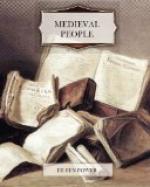Kublai Khan, and whom little men now dared to doubt.
Indeed, modern discovery has entirely confirmed the
exactitude of Marco Polo’s observation.
It is true that he sometimes repeated some very tall
stories which had been told to him, of dog-faced men
in the Andaman Islands and of the ‘male and female
islands’ so beloved of medieval geographers.
These were sailors’ yarns, and where Marco Polo
reports what he has seen with his own eyes, he reports
with complete accuracy, nor does he ever pretend to
have seen a place which he had not visited. The
explorers of our own day, Aurel Stein, Ellsworth Huntington,
and Sven Hedin, travelling in central Asia, have triumphantly
vindicated him. ‘It is,’ says an eminent
French historian, ’as though the originals of
very old photographs had been suddenly rediscovered:
the old descriptions of things which were unchanged
could be perfectly superimposed upon present reality,’[36]
and Huntington and Aurel Stein took with them to the
inaccessible districts of central Asia as guide-books
the book of the Chinese pilgrim Hiwen Thsang (seventh
century) and the book of Marco Polo, and over and over
again found how accurate were their descriptions.
It is indeed almost impossible to exaggerate the extent of Marco Polo’s accomplishment. It is best estimated in the often-quoted words of Sir Henry Yule, whose edition of his book is one of the great works of English scholarship:
He was the first traveller to trace a route across the whole longitude of Asia, naming and describing kingdom after kingdom, which he had seen with his own eyes, the desert of Persia, the flowering plateaux and wild gorges of Badakhshan, the jade-bearing rivers of Khotan, the Mongol steppes, cradle of the power that had so lately threatened to swallow up Christendom, the new and brilliant court that had been established at Cambaluc: the first Travellers to reveal China in all its wealth and vastness, its mighty rivers, its huge cities, its rich manufactures, its swarming population, the inconceivably vast fleets that quickened its seas and inland waters; to tell us of the nations on its borders with all their eccentricities of manners and worship; of Tibet with its sordid devotees; of Burma with its golden pagodas and their tinkling crowns; of Laos, of Siam, of Cochin China, of Japan, the Eastern Thule, with its rosy pearls and golden-roofed palaces; the first to speak of that Museum of Beauty and Wonder, still so imperfectly ransacked, the Indian Archipelago, source of those aromatics then so highly prized and whose origin was so dark; of Java the Pearl of Islands; of Sumatra with its many kings, its strange costly products, and its cannibal races; of the naked savages of Nicobar and Andaman; of Ceylon, the Isle of Gems, with its Sacred Mountain and its Tomb of Adam; of India the Great, not as a dreamland of Alexandrian fables, but as a country seen and partially explored, with its virtuous Brahmans, its obscene ascetics,




